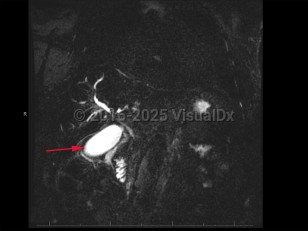Cholangiocarcinoma refers to biliary tree malignancies, primarily adenocarcinomas, of epithelial cell origin. They are typically categorized as intrahepatic, perihilar, or distal.
Cholangiocarcinomas often present insidiously; symptom onset often coincides with biliary duct obstruction leading to jaundice, pruritus, or cholangitis. Other less specific signs and symptoms include unexplained weight loss, lethargy, abdominal pain, nausea, and anorexia.
Cirrhosis, hepatitis B, hepatitis C, primary sclerosing cholangitis, and hepatobiliary flukes are known risk factors for cholangiocarcinoma. However, most cholangiocarcinomas develop in patients with no identifiable risk factors. It is a rare childhood malignancy. Incidence is highest in Hispanic and Asian populations.
Patients with cholangiocarcinoma will often have elevations in their liver function tests (total and direct bilirubin) and liver enzymes (aspartate transaminase [AST], alanine transaminase [ALT], alkaline phosphatase), although these are nonspecific findings. Elevations in cancer antigen (CA) 19-9, a tumor marker, can be suggestive of cholangiocarcinoma but are limited by nonspecificity. Diagnosis typically requires tissue sampling via endoscopic retrograde cholangiopancreatography (ERCP) with brushing.
Fibroblast growth factor receptor (FGFR) plays a role in driving the disease, and inhibitors of that growth factor are under study.
Overall prognosis is poor, as many patients present with advanced disease. Early detection of tumors that can be resected surgically portends the most favorable prognosis. Chemotherapy can slow disease progression but is rarely curative.
Cholangiocarcinoma
Alerts and Notices
Important News & Links
Synopsis

Codes
ICD10CM:
C22.1 – Intrahepatic bile duct carcinoma
SNOMEDCT:
70179006 – Cholangiocarcinoma
C22.1 – Intrahepatic bile duct carcinoma
SNOMEDCT:
70179006 – Cholangiocarcinoma
Look For
Subscription Required
Diagnostic Pearls
Subscription Required
Differential Diagnosis & Pitfalls

To perform a comparison, select diagnoses from the classic differential
Subscription Required
Best Tests
Subscription Required
Management Pearls
Subscription Required
Therapy
Subscription Required
References
Subscription Required
Last Reviewed:09/26/2017
Last Updated:01/12/2022
Last Updated:01/12/2022
Cholangiocarcinoma

